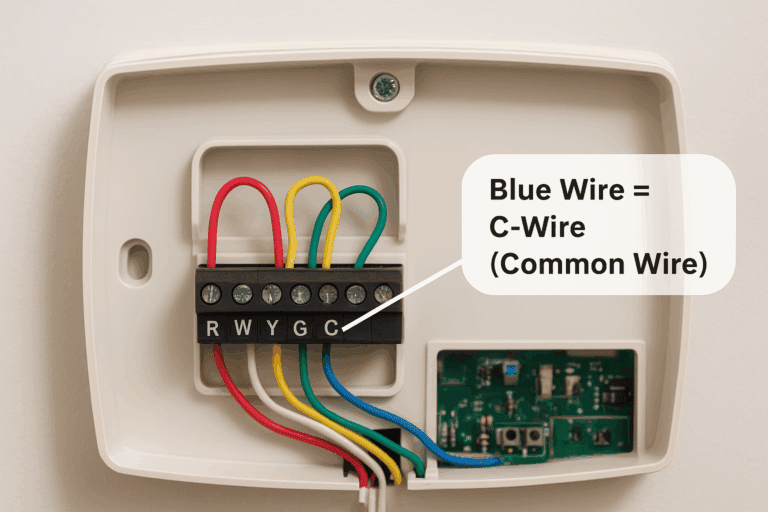Ever stared at the back of your thermostat and wondered, “What is the blue thermostat wire?” You’re not alone. For many Charlotte homeowners, thermostat wiring feels confusing and even intimidating. A wrong move could leave you without heat or AC, especially when you need it most. The good news is that understanding the blue thermostat wire isn’t as complicated as it seems, and knowing its role can save you time, frustration, and even repair costs.
What Is the Blue Thermostat Wire?

The blue thermostat wire, most commonly known as the C-wire or common wire, is one of the most important connections inside your thermostat system. Its main purpose is to provide a steady stream of power from your HVAC system to the thermostat.
Unlike older thermostats that could run on batteries alone, many modern thermostats, especially smart thermostats, need a constant power supply to stay connected to Wi-Fi, power their displays, and run updates. The blue wire makes this possible by completing the electrical circuit between your thermostat and your heating and cooling system.
Without the C-wire, you may notice issues like:
- Thermostat screens are going blank or flickering.
- Your system short short-cycling (turning on and off too quickly).
- Smart thermostats are disconnecting from apps or Wi-Fi.
- Trouble keeping a steady indoor temperature.
It’s important to note that while the blue wire is usually the common wire, not every system uses the same color coding. In some setups, the C-wire might be black, brown, or another color. This is why identifying it correctly (and not relying on color alone) is key before making adjustments.
In short, the blue thermostat wire acts as the “power lifeline” for today’s advanced thermostats, ensuring they run smoothly and reliably without depending solely on batteries.
Why the Blue Wire Matters in Charlotte Homes
Charlotte’s weather can swing from humid summers to chilly winters. If your thermostat isn’t getting the right power supply, it can cause problems like:
- Flickering or blank thermostat screens
- Heating or cooling cycles that stop unexpectedly
- Smart thermostats failing to connect or update
Knowing what the blue thermostat wire does helps ensure your system runs smoothly year-round, keeping your home comfortable no matter the season.
How to Identify the Blue Thermostat Wire
Finding and confirming the blue thermostat wire doesn’t have to be overwhelming. Here’s a simple step-by-step approach Charlotte homeowners can follow:
Turn off the power
Always start by shutting off your HVAC system at the breaker. This keeps you safe and prevents accidental damage.
Remove the thermostat cover
Gently pop off or unscrew the cover to expose the wiring behind your thermostat.
Look for wire labels
Thermostat wires are usually labeled with letters like R, W, Y, G, and C. The blue wire is often connected to the C terminal.
Check wire colors—but don’t rely on them alone
The common wire is often blue, but in some systems it could be black, brown, or even another color.
Verify at the control board
If you’re unsure, follow the wire back to your HVAC control board (usually near your furnace or air handler). If it connects to the C terminal there, you’ve found the right one.
Pro tip for Charlotte homeowners: Some older systems may not have a C-wire at all. If that’s the case, you’ll need a professional to add one or install a power adapter kit so your smart thermostat works properly.
Should You Handle Thermostat Wiring Yourself?
While identifying wires can seem straightforward, handling HVAC wiring without experience carries risks. Incorrect wiring could damage your thermostat or your system. If you’re unsure, it’s always best to call a professional HVAC technician in Charlotte. They can safely connect the blue thermostat wire and ensure everything is working as it should.
Conclusion
Understanding what the blue thermostat wire is helps Charlotte homeowners see how their HVAC system stays powered and keeps smart thermostats running reliably. The blue wire, or C-wire, provides continuous electricity to prevent issues like flickering screens, short cycling, or connectivity problems.
While knowing how to identify it is useful, handling thermostat wiring can be risky; mistakes could damage your system or leave your home without heat or AC. If you’re unsure, it’s always best to ask a professional HVAC technician for help to ensure your system operates safely and efficiently year-round.



